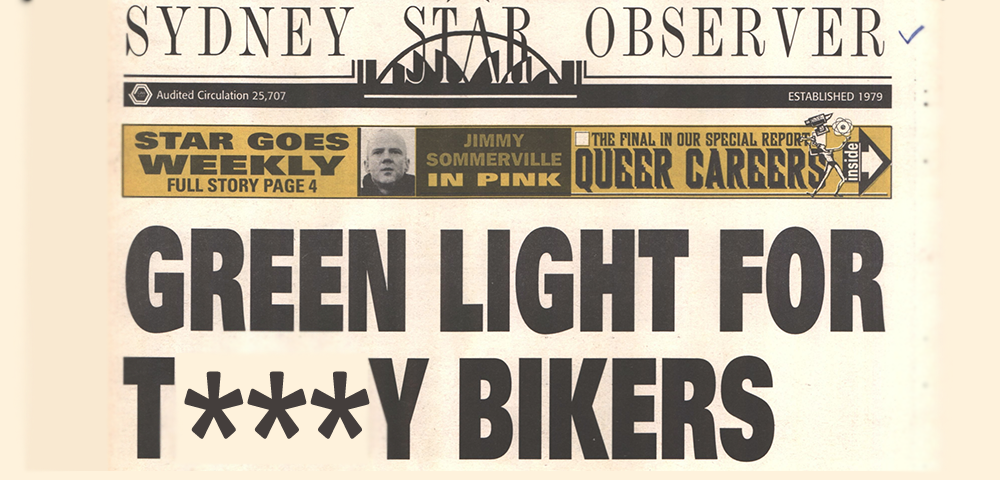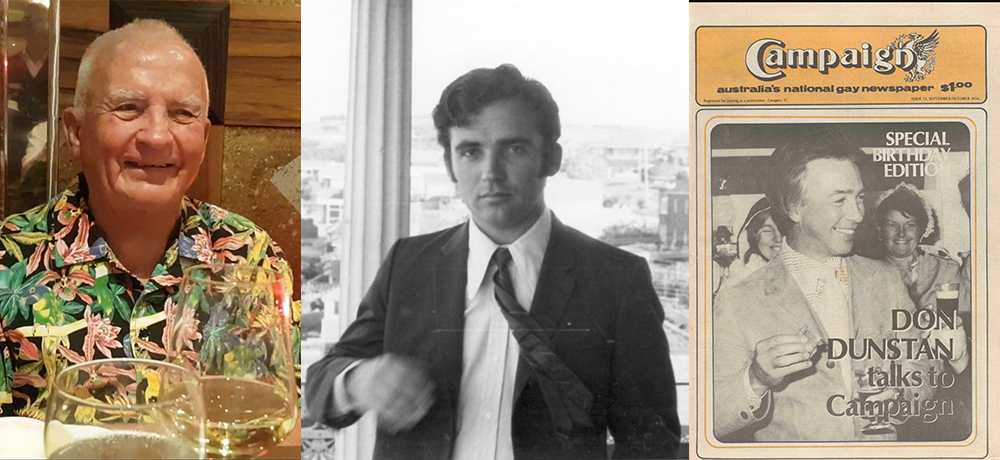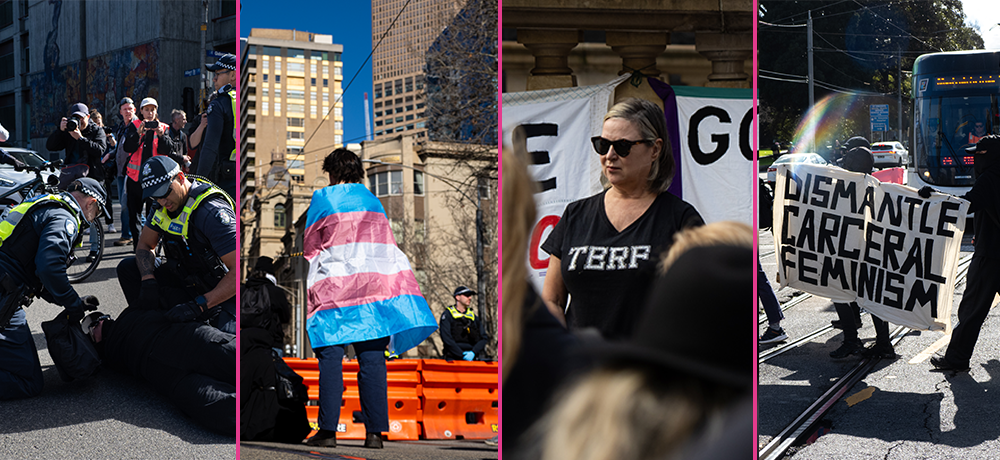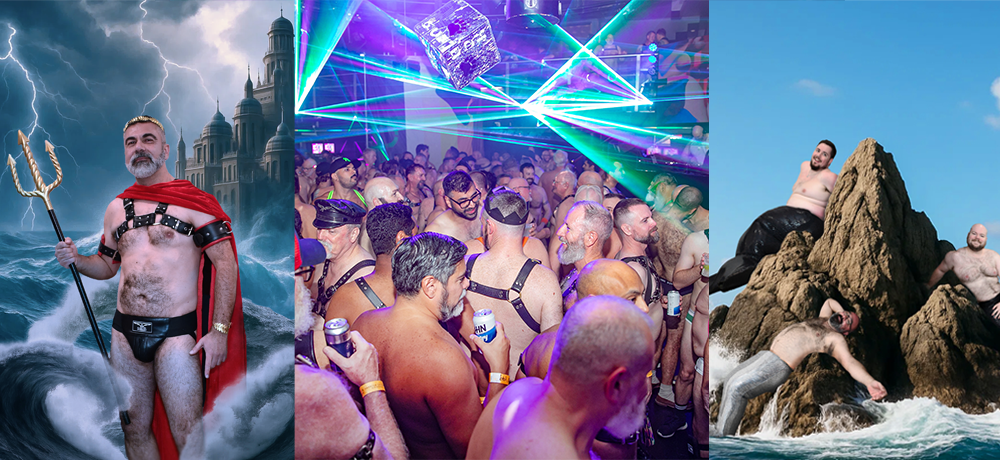
From The Archives: Dykes on Bikes vote on trans inclusion, 1995

From Our Archives: 27 July, 1995
Subscribe to read the full story in the Star Archives.
GREEN LIGHT FOR TRANY BIKERS
The Star announced after Dykes on Bikes held a ‘civil and friendly meeting’ at the Iron Duke Hotel to settle the question of trans membership once and for all.

Star contributor Kimberley O’Sullivan reported Dykes on Bikes voted overwhelmingly in favour of trans inclusion during a meeting at the Iron Duke Hotel in Alexandria in July 1995 (Star Observer, page one, 27 July 1995).
There were 30 votes in favour, 12 against and two abstentions.
The battle over trans inclusion erupted for Dykes on Bikes after a member wrote an anonymous letter to the organisation’s secretary raising concerns about “the admittance of people other than female born lesbians”.
“While the media was excluded from the meeting, members afterwards described the discussion on transgender membership as civil and friendly,” the Star reported.
A spokesperson for the Transgender Liberation Coalition, Aidy Griffin, described the Dykes on Bikes vote as “a rejection of divisive and sectarian politics and a signal to those few remaining organisations who exclude tranys that they are isolated from general lesbian opinion.”
For too many decades, lesbian and gay organisations including the Star found it difficult to include trans members. The ill-fated Lesbian Space Project could not agree on the question, nor could the Gay and Lesbian Rights Lobby, which split after a motion to expel transgender activist Norrie-May Welby was carried by two votes in March ’93.
Sydney’s gay bars and clubs were similarly exclusionist, unless trans and gender diverse people were there to entertain. In which case, exceptions were made.
“Lesbian Rights, Gay Rights, Trany Rights Now!”
When the Star made space for trans voices, Norrie-May Welby let rip:
“Trannies have been part of the queer community since the Stonewall uprising of 1969, but in our individual struggles … we have often distanced ourselves from our gay male and lesbian siblings.
“The powerbrokers in the queer community, usually being from the more mainstream backgrounds (ie: white, upper middle class, anglo-centric, politically conservative and philosophically conventional) seem to have overlooked their tranny sisters and brothers when the “gay” movement was renamed the “gay and lesbian” movement.
“Whilst I have no argument with the need for lesbian visibility that led to this change in the ‘80s, it’s a pity that “gay” was then re-interpreted to mean “gay males” (or even “gay men”, a term that excludes gay youth, but then, they’re so often disempowered . . . but I digress).
“Trannies were welcome in the Gay and Lesbian Mardi Gras. We worked in gay and lesbian bars, nightclubs and other events, we did the shows, we designed the lights, we checked the coats, we served at the bar, we worked the door.”
“We were definitely at the Gay and Lesbian Party, as it were, but without an invite,” Norrie-May Welby wrote in Gender Agenda (Star Observer, 13 November 1992)
Welby noted how the Stonewall March in Sydney earlier that year was supported by thousands of lesbians, gay males, trannies, other queers and their supporters, who chanted “Lesbian Rights, Gay Rights, Trany Rights Now!”
The Anti-Violence Project (AVP) had also stepped up, welcoming for the first time a trans person in its gay and lesbian self-defence course, in October 1992.
“The AVP may run a tranny-specific course if there’s enough interest. Their number is 360 6650. Tell them I sent you!,” Welby wrote.
“Consciousness-raising, knowing that it’s okay to be who we are, whatever that may be for every individual tranny, and knowing that there’s a place for us here in the queer community (for those of us who don’t opt to forever assimilate in the straight world, of course, an undeniably valid lifestyle choice), are very much on the agenda in the nineties.
“Visible acceptance. It’s our right!”
In claiming a place for trans and gender diverse people and by asserting the importance of visibility and consciousness-raising, Welby argued for no more nor less than what gays and lesbians demanded themselves.
More than half a million lesbians and gays marched on Washington in April the following year, motivated by a very clear agenda:
“The Lesbian, Gay, Bisexual, and Transgender movement recognises that our quest for social justice fundamentally links us to the struggles against racism and sexism, class bias, economic injustice and religious intolerance,” the 1993 March on Washington statement said.
“We must realise if one of us is oppressed we are all oppressed. The diversity of our movement requires us to stand in opposition to all forms of oppression that diminishes the quality of life for all people.
“We will be vigilant in our determination to rid our movement and our society of all forms of oppression and exploitation, so that all of us can develop to our full human potential without regard to race, religion, sexual orientation/identification, identity, gender and gender expression, ability, age, or class.” (Reprinted in the Star Observer, page 14, 21 August 1992.)









